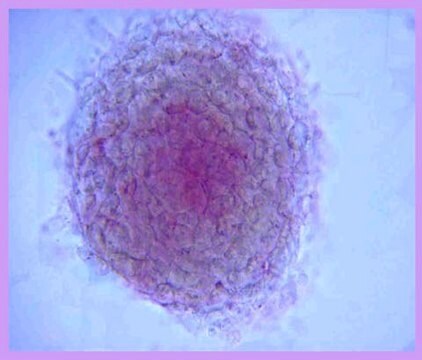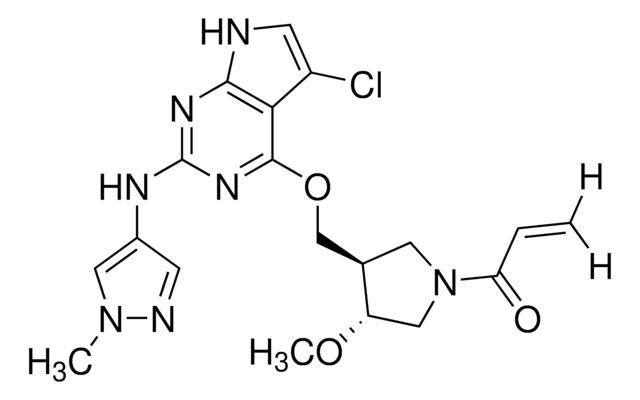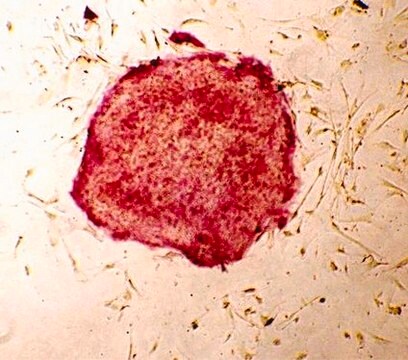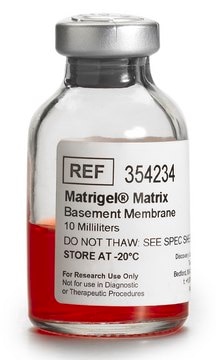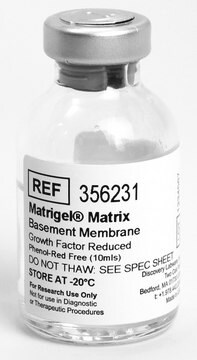SCR077
Fluorescencyjny zestaw do charakteryzacji mysich komórek ES/iPS
This Fluorescent Mouse ES/iPS Cell Characterization Kit contains a range of sensitive tools for the phenotypic assessment of the pluripotent status of mouse Embryonic stem & induced pluripotent Stem cells.
Zaloguj sięWyświetlanie cen organizacyjnych i kontraktowych
About This Item
Kod UNSPSC:
12161503
eCl@ss:
32161000
NACRES:
NA.84
Polecane produkty
Opis ogólny
Mysie embrionalne komórki macierzyste (mES) to pluripotencjalne komórki pochodzące z wewnętrznej masy komórkowej przedimplantacyjnych blastocyst. Indukowane mysie komórki pluripotencjalne (miPS) to komórki pluripotencjalne generowane przez przeprogramowanie mysich komórek somatycznych przy użyciu czterech czynników transkrypcyjnych, Oct-4, Klf-4, Sox-2 i c-Myc lub ich wariantów. Zarówno mESC, jak i miPSC mogą się samoodnawiać i mają zdolność do generowania wszystkich trzech warstw zarodkowych: ektodermy, mezodermy i endodermy. In vitro, mESC/iPSC są zwykle utrzymywane i rozmnażane na podajnikach fibroblastów myszy lub w warunkach bez podajnika w pożywce zawierającej LIF/ESGRO. Jednakże, spontaniczne różnicowanie może wystąpić w subpopulacjach komórek. W celu odróżnienia pluripotencjalnych mESC/iPSC od zróżnicowanych komórek powszechnie stosuje się kilka markerów pluripotencjalnych.
Zestaw EMD Millipore Fluorescent Mouse ES/iPS Cell Characterization Kit zawiera szereg czułych narzędzi do fenotypowej oceny statusu pluripotencjalnego mysich komórek ES/iPS. W zestawie znajduje się test enzymatyczny do pomiaru aktywności fosfatazy alkalicznej w komórkach wraz ze zwalidowanymi bezpośrednio sprzężonymi przeciwciałami do pluripotencjalnych czynników transkrypcyjnych, Oct-4, Sox-2 i DPPA-2 oraz epitopu powierzchni komórki SSEA-1, aby umożliwić szybką analizę markerów immunocytochemicznych. Barwnik jądrowy Dapi jest dogodnie dołączony, aby pomóc w kwantyfikacji komórek. Chociaż oczekuje się, że poziomy ekspresji markerów pluripotencjalnych zmniejszą się po różnicowaniu, każdy z nich ma specyficzną kinetykę ekspresji.
Zestaw EMD Millipore Fluorescent Mouse ES/iPS Cell Characterization Kit zawiera szereg czułych narzędzi do fenotypowej oceny statusu pluripotencjalnego mysich komórek ES/iPS. W zestawie znajduje się test enzymatyczny do pomiaru aktywności fosfatazy alkalicznej w komórkach wraz ze zwalidowanymi bezpośrednio sprzężonymi przeciwciałami do pluripotencjalnych czynników transkrypcyjnych, Oct-4, Sox-2 i DPPA-2 oraz epitopu powierzchni komórki SSEA-1, aby umożliwić szybką analizę markerów immunocytochemicznych. Barwnik jądrowy Dapi jest dogodnie dołączony, aby pomóc w kwantyfikacji komórek. Chociaż oczekuje się, że poziomy ekspresji markerów pluripotencjalnych zmniejszą się po różnicowaniu, każdy z nich ma specyficzną kinetykę ekspresji.
Specyficzność
Reaktywność krzyżowa
Brak
Brak
Zastosowanie
Fluorescencyjny zestaw do charakteryzacji mysich komórek ES/iPS zawiera szereg czułych narzędzi do fenotypowej oceny pluripotencjalnego statusu mysich embrionalnych komórek macierzystych i indukowanych pluripotencjalnych komórek macierzystych.
Research Category
Stem Cell Research
Stem Cell Research
Research Sub Category
Pluripotent & Early Differentiation
Pluripotent & Early Differentiation
Komponenty
1. Fast Red Violet solution (Part No. 90239): One 15 mL bottle.
2. Napthol AS-BI phosphate solution (Part No. 90234). One 15 mL bottle.
3. Mouse anti-Oct-4 (POU5f1), clone 7F9.2, Alexa Fluor™ 488 conjugate (Part No. MAB4419A4-50UL). One vial containing 50 µL of 0.5 mg/mL conjugated monoclonal antibody.
4. Mouse anti-Sox-2, clone 10H9.1, Cy3 conjugate (Part No. MAB4423C3-50UL). One vial containing 50 µL of 0.5 mg/mL conjugated monoclonal antibody.
5. Mouse anti-DPPA-2, clone 6C1.2, Alexa Fluor 488 conjugate (Part No. MAB4356A4-50UL). One vial containing 50 µL of 0.5 mg/mL conjugated monoclonal antibody.
5. Mouse anti-SSEA-1, clone MC-480, Cy3 conjugate (Part No. MAB4301C3-50UL). One vial containing 50 µL of 0.5 mg/mL conjugated monoclonal antibody.
8. DAPI, 100 µL (Part No. 90229). One vial containing 100 µL volume.
2. Napthol AS-BI phosphate solution (Part No. 90234). One 15 mL bottle.
3. Mouse anti-Oct-4 (POU5f1), clone 7F9.2, Alexa Fluor™ 488 conjugate (Part No. MAB4419A4-50UL). One vial containing 50 µL of 0.5 mg/mL conjugated monoclonal antibody.
4. Mouse anti-Sox-2, clone 10H9.1, Cy3 conjugate (Part No. MAB4423C3-50UL). One vial containing 50 µL of 0.5 mg/mL conjugated monoclonal antibody.
5. Mouse anti-DPPA-2, clone 6C1.2, Alexa Fluor 488 conjugate (Part No. MAB4356A4-50UL). One vial containing 50 µL of 0.5 mg/mL conjugated monoclonal antibody.
5. Mouse anti-SSEA-1, clone MC-480, Cy3 conjugate (Part No. MAB4301C3-50UL). One vial containing 50 µL of 0.5 mg/mL conjugated monoclonal antibody.
8. DAPI, 100 µL (Part No. 90229). One vial containing 100 µL volume.
Jakość
Conjugated antibodies and alkaline phosphatase reagents have been validated on mouse ES and STEMCCA derived mouse ips cells.
Postać fizyczna
Oczyszczone sprzężone mysie przeciwciała monoklonalne są przechowywane w PBS z 0,1% azydkiem sodu i 15 mg/ml BSA.
Przechowywanie i stabilność
Przechowywać w temperaturze 2-8°C do daty ważności zestawu. Nie zamrażać ani nie wystawiać na działanie podwyższonych temperatur. Wyrzucić wszelkie pozostałe odczynniki po upływie daty ważności.
Informacje prawne
ALEXA FLUOR is a trademark of Life Technologies
Ta strona może zawierać tekst przetłumaczony maszynowo.
Hasło ostrzegawcze
Warning
Zwroty wskazujące rodzaj zagrożenia
Zwroty wskazujące środki ostrożności
Klasyfikacja zagrożeń
Carc. 2 - Eye Irrit. 2 - Skin Irrit. 2
Kod klasy składowania
10 - Combustible liquids
Certyfikaty analizy (CoA)
Poszukaj Certyfikaty analizy (CoA), wpisując numer partii/serii produktów. Numery serii i partii można znaleźć na etykiecie produktu po słowach „seria” lub „partia”.
Masz już ten produkt?
Dokumenty związane z niedawno zakupionymi produktami zostały zamieszczone w Bibliotece dokumentów.
Yanbo Zhu et al.
International journal of biological sciences, 16(11), 1861-1875 (2020-05-14)
Induced pluripotent stem cells (iPSCs), derived from reprogramming of somatic cells by a cocktail of transcription factors, have the capacity for unlimited self-renewal and the ability to differentiate into all of cell types present in the body. iPSCs may have
Zhonghua Du et al.
Scientific data, 5, 180255-180255 (2018-11-21)
Pluripotent stem cells hold great investigative potential for developmental biology and regenerative medicine. Recent studies suggest that long noncoding RNAs (lncRNAs) may function as key regulators of the maintenance and the lineage differentiation of stem cells. However, the underlying mechanisms
Zhonghua Du et al.
Genome biology, 22(1), 233-233 (2021-08-21)
A specific 3-dimensional intrachromosomal architecture of core stem cell factor genes is required to reprogram a somatic cell into pluripotency. As little is known about the epigenetic readers that orchestrate this architectural remodeling, we used a novel chromatin RNA in
Lin Jia et al.
Nucleic acids research, 48(7), 3935-3948 (2020-02-15)
Formation of a pluripotency-specific chromatin network is a critical event in reprogramming somatic cells into pluripotent status. To characterize the regulatory components in this process, we used 'chromatin RNA in situ reverse transcription sequencing' (CRIST-seq) to profile RNA components that
Protokoły
Protokoły hodowli ludzkich indukowanych pluripotencjalnych komórek macierzystych (iPSC) krok po kroku, w tym rozmrażanie, ekspansja, zamrażanie i charakteryzowanie komórek ips.
Nasz zespół naukowców ma doświadczenie we wszystkich obszarach badań, w tym w naukach przyrodniczych, materiałoznawstwie, syntezie chemicznej, chromatografii, analityce i wielu innych dziedzinach.
Skontaktuj się z zespołem ds. pomocy technicznej